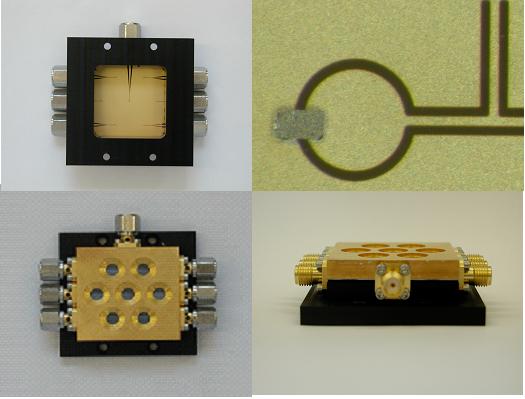Monolithic
Millimeter-Submillimeter Wave Active Conical Horn Antenna Arrays
EPSRC Research Grant, GR/R16945/01(P), Starts: 03/05/01, Ends: 02/05/2004,
Value: £66,950
Background/International Context:
This project
was funded to Dr Hao by EPSRC under the fast stream scheme in May 2001.
The main objective was to characterise and implement a monolithic active
conical horn antenna array for millimetre/submillimetre wave imaging
applications. This proposal can be described as having two main aims:
- To research a fast and accurate electromagnetic algorithm to analyse the proposed conical horn antenna arrays;
- To design and build a demonstrator of the proposed active conical horn antenna arrays in order to validate the design methodology and simulation.
Imaging arrays can be used as millimetre wave cameras that allow one
to see through human clothing for concealed weapon detection, as well
as radio astronomy instruments for all weather conditions. For some
time now, researches have been very active in California Institution
of Technology, University of Michigan, Ann Arbor and TRW in USA. The
work in UK started in late 90s with a project partially funded by ESTEC
at Queen Mary, University of London. This fast stream fund has allowed
that the innovation is continued in this area. In addition, the project
has helped more novel approaches developed on a local distorted nonorthogonal
Finite Difference Time Domain (FDTD) method (pioneered by Dr Hao), to
strengthen and expand the UK position in this field.
Key Advances and Supporting Methodology:
- Late Time Instabilities in the Nonorthogonal FDTD Method and A New ‘Time Sub-griding’ Scheme
- A Stable Non-orthogonal FDTD Method
- A Conical Horn Antenna with Hard Surfaces
- Fast
Array Analysis Using a Combination of FDTD and Matrix Manipulation
Techniques
The Active Conical Horn Antenna Array
Photographs
of the fabricated hard surface conical horn antenna array with its associated
slot ring mixers

Individual Grant Review Report (PDF).
References
[1] Rebeiz G.M., Katehi L.P.B., et al. “Integrated Horn Antennas for
Millimeter-Wave Applications”, IEEE Antennas and Prop. Magazine, Volume:
34, No. 1, pp. 7-16, Feb. 1992
[2] Y. Hao, C.J. Railton, “Analyzing Electromagnetic Structures With
Curved Boundaries on Cartesian FDTD Meshes”, IEEE Trans. on Microwave
Theory and Techniques, vol. 46, pp. 82-88, Jan.1998
[3] V. Douvalis, Y. Hao, ‘A Monolithic Active Conical Horn Antenna Arrays
for Millimeter and Sub-Millimiter Wave Applications’, the 2004 IEEE
AP-S International Symposium on Antennas and Propagation and USNC/URSI
National Radio Science Meeting to be held in Monterey, California, USA
on June 20-26, 2004.
[4] Y. Qian and T. Itoh, ‘Progress in Active Integrated Antennas and
Their Applications’, IEEE Trans. MTT, Vol. 46, No.11, Nov. 1998, pp.
1891-1990.
[5] Rebeiz G.M., et. al. “Monolithic Millimeter-Wave Two-Dimensional
Horn Imaging Arrays”, IEEE Transactions on Ant.&Prop., Vol.38, No.9,
pp. 1473-1482, Sep, 1990.
[6] Eleftheriades G.V. and Rebeiz G.M, “Design and Analysis of Quasi-Integrated
Horn Antennas for Millimeter and Submillimeter-Wave Applications” IEEE
Transactions on Microwave Theory and Techniques. , Vol.41, No. 6/7,
pp. 954-965, June/July 1993
[7] Uehara K., et al., “Lens-Coupled Imaging arrays for the Millimeter
and Submillimeter-Wave Regions” IEEE Transactions on Microwave Theory
and Techniques. , Vol.40, No. 5, pp. 806-811, May 1992.
[8] Y. Hao, Chris Railton, 'An efficient and accurate FDTD algorithm
for the treatment of curved material boundaries', pp. 382-388, IEE Proceedings,
Part H, Vol. 144, No. 5, Oct. 1997.
[9] Y. Hao, V. Douvalis and C. G.Parini, “Reduction of late time instabilities
of the finite difference time domain method in curvilinear coordinates”,
IEE Proceedings-Science, Measurement and Technology, Vol. 149, No. 5,
pp.267-272, Sept. 2002
[10] Y. Hao, Railton CJ. “Efficient determination of Q factor by structured
nonorthogonal FDTD method”. Electronics Letters, vol.34, no.19, 17 Sept.
1998, pp.1834-6. Publisher: IEE, UK.
[11] V. Douvalis, Y. Hao and C. G. Parini, ‘A stable non-orthogonal
FDTD method’, accepted by Electronics Letters, 2004.
[12] Skobelev S. P., Kildal P.-S., “Analysis of conical quasi-TEM horn
with a hard corrugated section,” IEEE Trans. Antennas Propagat., vol.
51, pp. 2723-2731, Oct. 2003.
[13] V. Douvalis, Y. Hao and C. G. Parini, 'Modelling of A Hard Conical
Horn Antenna Using Local Distorted Nonorthogonal FDTD Method', the 27th
ESA Antenna Technology Workshop on Innovative Periodic Antennas to be
held in Santiago de Compostela, Spain, 9-11 March 2004.
[14] C. J. Railton, G. S. Hilton, “The analysis of medium-sized arrays
of complex elements using a combination of FDTD and reaction matching,”
IEEE Trans. Antennas Propagat., vol. 47, pp. 707-714, April 1999.
[15] V. Douvalis, Y. Hao and C. G. Parini, “Fast Array Analysis Using
a Combination of FDTD and Matrix Manipulation Techniques” to be submitted
to IEE Proceedings, Part H.
[16] V. Douvalis, Y. Hao and C. G. Parini, “Conical Horn Antenna Array
Analysis Using Matrix Manipulation In Conformal FDTD Scheme”, Vol.1,
pp.94-97, ICAP 2003, Exeter, UK.
[17]V. Douvalis, Y. Hao and C. G. Parini, “Modeling Conical Horn Antennas
Using Local Distorted Nonorthogonal FDTD Method", Vol.1, pp. 67-70,
Jina 2002, 12th International Symposium on Antennas. France.
For more information on our research, please contact Prof. Y. Hao .

